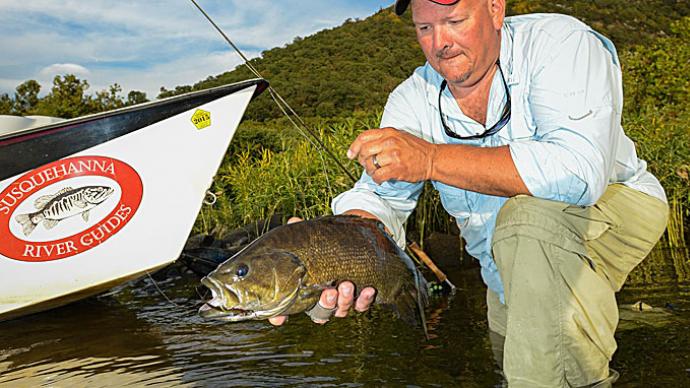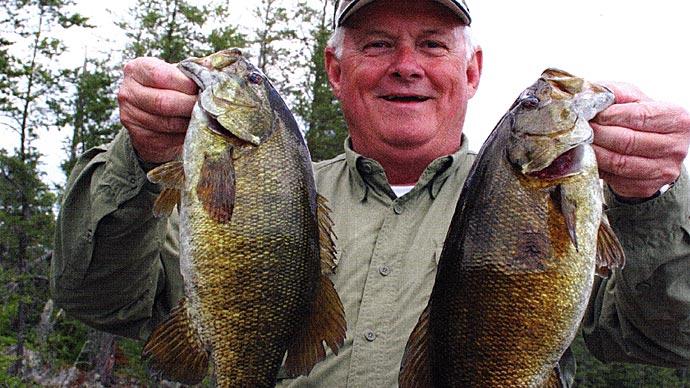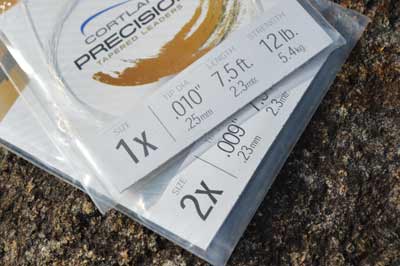
Glowing sunsets, fading light, and cooling temperatures make summertime evenings perfect for fishing. Watching a bass break the surface to grab your offering is the only thing that makes it better, especially if it’s presented with a fly rod. It’s a scene steeped in nostalgia.
High-tech casting and spinning outfits fill most bass anglers’ hands. But some reach for a fly rod, enjoying the process of developing the skills it demands. While smallmouth are a more popular target, summertime largemouth presents an exciting topwater opportunity, especially if the waters you fish — from small ponds to expansive natural lakes — are filled with aquatic vegetation such as lily pads.
Gearing up to fly fish for summertime largemouth is a straightforward process, said Dave Hise, owner of Casters Fly Shop in Hickory, North Carolina. But that doesn’t mean it’s clear-cut, especially if your background is conventional gear. Fly rods, reels, and line have their rating system, for example, flies are offered in sizes, not weights.
But don’t let those differences keep you from picking up a fly rod. A little knowledge and practice will go a long way to making your fly fishing dreams a reality. Having the proper gear is paramount. And Hise is here to help you assemble it.
Rod
The backbone of any fishing outfit is the rod. But while conventional gear launches a weighted fishing lure, a fly rod casts the line. Fly rods are selected for the size of flies you're fishing — in this case fairly large — not the fish you’re pursuing. Hise says 7- and 8-weight rods are best for largemouth.
While a few exceptions are available if you look hard enough, most measure 9 feet long and are made of graphite. A few are built on blanks made from fiberglass or bamboo. “A lot of people use glass just for the novelty,” he said. “But I wouldn’t use one [for largemouth]. It’s pretty slow to be swinging big bugs around. I like the faster feel. I would use tip flex just for the power.”
Flex is how Vermont-based Orvis rates the action of the fly rods it manufactures. While other rod-makers use slow, medium, and fast, it uses full flex, mid-flex, and tip flex, respectively. Hise said all Orvis rods 7-weight and heavier have a tip-flex action. It loads better under the strain of the heavy line, leading to longer, smoother, accurate casts.
Reel
Fly rods require a reel. And while it plays a role in landing large salmon, trout, and saltwater species, its job is much more basic when you’re chasing largemouth: It’s a place to store line that’s not in use. And while every fly reel handles that, some offer a performance gain.
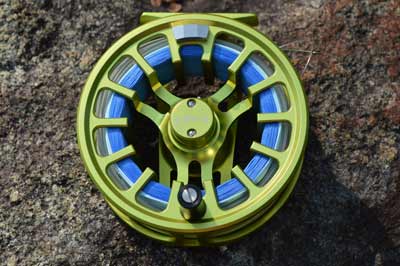
Fly reels are available in many different materials, including billet aluminum. Some have silky smooth drags to slow and stop the fish mentioned above. And they all are sized by line weight, making it easy to match one to your rod correctly.
Hise said bass anglers should be most concerned with a fly reel’s arbor size — standard, mid and large. Reels with large arbors, such as Orvis’ Hydros, wrap line in coils bigger than those made by mid and standard ones. “If you store line on [a mid or standard arbor] reel, it will come out like a Slinky,” he said. “Many less expensive and older lines will retain that memory, making it more difficult to cast.”
Line
When divvying up your fly-fishing outfit budget, Hise said line — followed by rod then reel — should get the most money. It creates casts, works, flies, and lands bass. While sticker shock may steer you toward the least expensive one, a little more investment here pays big dividends.
Hise said that the more you pay for a fly line, the more choices you’ll have. There are lines, for example, specifically designed for casting bass poppers. He said a big part of a line’s price stems from its coating. Higher-priced lines, for example, have slippery ones, maximize casting distance and challenge, and reduce the need for regular cleaning.
Choosing your line size and style is straightforward. Size is based on a line’s weight in grains or grams. Depending on that amount, it’s assigned a number from 1, the lightest, to 14, the heaviest. You’ll want a 7- or 8-weight line for your largemouth outfit, whichever matches your rod and reel.
Hise said you’ll need a floating weight-forward fly line. The floating part is self-explanatory for popper fishing. The weight forward comes from the line’s taper. By making its diameter larger toward its tip, casting power is magnified. Think of it like tying a weight to the end of a rope. You can throw it farther than a rope without one.
While it’s impossible to go wrong if you match the line’s weight to rod and reel, there are times when it’s an advantage to spool up with one size heavier line, such as 9-weight on an 8-weight rod. Hise said some lines, such as Orvis’ Power Taper, are designed heavier, so an 8-weight, for example, is an 8 1/2 weight. That additional weight makes loading fast action fly rods easier, and the more you load one, the easier it casts.
Hise said “over lining” also helps you cast bigger flies and cut through conditions. “Saltwater anglers often do it,” he said. “If you’re fishing largemouth, usually it’s on bigger waters, like lakes, so it’s going to be windy.”
The fly line won’t fill an entire spool by itself regardless of arbor size. So, use braided backing behind your line. Arbor size and line weight dictate how much you’ll need. Check the box or manual that comes with your reel. Backing amounts typically are listed there.
Leader
A leader connects your fly line and fly. Tapered to help turn over your fly during the cast and create a proper presentation, most use a loop-to-loop connection to your fly line. Hise said you won’t go wrong with one measuring 9 feet. Strength is rated in pound test, like conventional fishing lines or the traditional “X” system. A 1X leader, for example, is equivalent to about 14-pound test.
While you might be tempted to choose a leader based on the amount of cover you’ll be fishing, Hise said to match it to the flies you are throwing. Heavy wind-resistant poppers, for example, require a larger diameter — stronger — leader. He said they create enough stress during a cast to break a 3X or 4X leader.
Hise said fluorocarbon leaders offer more advantages than nylon ones. First, they’re stiffer, helping the line straighten at the end of your cast. They absorb less water, staying stronger longer. And while fluorocarbon’s density causes topwater lures to sink on long casts with conventional gear, the relatively short leader length doesn’t present that concern. “It will sink a size 16 parachute Adams [trout fly], but you don’t have to worry about it sinking a popper,” he said. It causes the popper to ride lower in the water, creating different sounds and actions.
Flies
Surface flies for summertime largemouth fall into three categories: poppers, sliders, and divers. Hise said within those categories, you’ll want ones from size 6 — the smallest — to size 1.
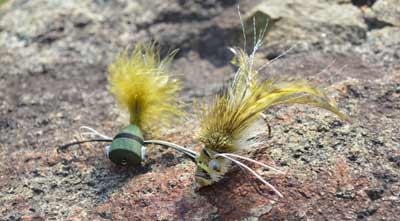
Popper choices are straightforward. They come in a variety of colors. Old-school choices, such as red and white, yellow and frog patterns, still produce. And the addition of rubber legs means more action and a bigger target for bass. Hise said Boogle Bugs, popular with smallmouth fly anglers, are a good choice.
Hise said sliders, such as a Sneaky Pete, work at or just under the surface. Like poppers and divers, they are best fished on stop-and-go retrieves. Create those movements by stripping small amounts of line, not by moving your rod’s tip.
Divers, such as Dahlbergs, are the largest of the surface flies. Each is tied with spun deer hair, which is shaved to create a lip across its back. And as its name applies, it dips down with each line strip and then floats back to the surface when the retrieve is paused. While these create a lot of commotion, they can cause frustration. “Some deer hair bugs are pretty large, and they move a lot of water,” he said. “They also are tough to cast.”
One thing Hise likes to see on all his bass flies are eyes. He believes warmwater predators use them as targets, helping them swallow a small fish head first. That folds down spiny dorsal fins, keeping meals from sticking in their throat.
Cast
In the right hand, a fly rod makes beautiful movements as it propels its line back and forth through the air. That quickly becomes a tangled mess in the wrong ones. But with some practice, it’s easy to straighten out your casting, even if you’re a novice. Hise offered a few tips to get you headed in the right direction.
When it comes to casting big flies for largemouth, especially when the wind is blowing, Hise sees many anglers make the mistake of putting too much power into their cast. He said that creates prime conditions for tailing loops, which tie unwanted knots in your leader.
Smooth moves are the foundation of good fly casting. Go with the flow, allowing the line’s weight to load the rod before changing directions. Hise recommends keeping your wrist locked except for a slight flick at the end of each swing, stopping at the equivalent of 10 and 2 on a clock face. But don’t follow its arc with your rod’s tip. “It’s a straight line between 10 and 2,” he said.
Hise also suggests keeping your backstroke slightly higher than your forward stroke. That’s accomplished by punching your thumb forward, like hitting a nail with a hammer, on your forward swing.
Keeping your rod’s tip moving in a straight line creates tighter loops in your cast, making it less affected by the wind. If you’re right-handed, keeping the wind blowing from your left and a little behind will make casting easier. “That’s ideal, but it doesn’t always work that way,” he said.


